1
On Smart Cities: A Literature Review
Thus far, we have established – with a fair amount of confidence – that functional geography has gradually come to prevail, overshadowing the significance and governance associated with political geography. We have also highlighted that global urbanization is putting serious pressure on big cities in terms of their ability to accommodate additional inhabitants, and that this pressure is being passed onto the construction industry which is currently hastening developments: smart cities. Furthermore, we have shed light on the importance of promoting macro-level connectivity as a means of boosting economic growth and sponsoring environmental sustainability and political stability1.
Besides macro-level connectivity, we endeavor in this work to demonstrate that connectivity is critical at the micro-level too (Hanna 2009). Clearly, there is now a need to institute strong micro-level connectivity (within the construction industry) and rethink existing stakeholder management approaches, for the most part to improve stakeholder engagement throughout the various stages of the CPLC (Construction Project Lifecycle). In fact, establishing strong links between construction actors – maintaining open channels of communication at all times – has become a prerequisite to successful construction projects. This is palpable – in our opinion – because stakeholders often have distinct interests and concerns, and therefore strong connections at the micro-level – if they could exist – would ensure timely, consistent, relevant exchanges of information between them. The result is the successful execution of smart development projects.
However, connections at the micro-level connectivity cannot be established without the intervention of a key industry player who is both a connector and a maven: the general contractor.
In summary, this chapter explains the smart city concept in detail.
The research is then explored further to address the crucial role of the general contractor in managing the construction value chain (Chapter 2).
From our perspective, the general contractor role exists because of the presence of (a major issue) broad organizational gaps and weaknesses within the construction industry’s value chain, which often hold construction actors back from proposing value-adding innovations to their clients. As for the solution to this particular issue, we declare it is nowhere to be found except in a newly-designed – centralized – stage-based business model.
Over the course of my professional career as a general contractor, I have had the opportunity to handle numerous construction projects and amass sufficient knowledge about the current state of the market: its strengths, weaknesses, the threats faced and future prospects to be seized. In my personal view, smart cities are likely to shape the future of urban developments. The smart city market in France, as well as in other countries, has lots to offer and has been growing exponentially, especially with the global urbanization trend which has erupted in recent years and has been on the rise ever since.
Practically, smart city projects refer to long-term construction projects that are generally labor-, capital- and technology-intensive. To say the least, they are a source of value, creating various revenue streams that could potentially benefit all construction actors2.
Currently, the number of construction actors – those intervening at different stages of the construction value chain in order to execute smart city projects – is significant; however, the difficulty encountered in this context has very little to do with the number of those involved. Instead, it stems from the absence of an entrepreneurial entity that could resourcefully orchestrate these interventions, avoid overlapping roles and guarantee the successful delivery of projects (Flyvbjerg and Holm 2002; Flyvbjerg et al. 2003).
1.1. Historical synopsis
The concern surrounding sustainable development of urban centers has been a central preoccupation for many years, and the aspects that typify the cities of tomorrow have been embraced during this time. Furthermore, the vocabulary associated with the features of these cities has been unequivocally enhanced over the past few decades, mainly to explain the substantial number of concepts endorsed by stakeholders (Eremia et al. 2017). Today, this vocabulary has changed once again, with specific terms gaining or losing ground over time (see Tables 1.1 and 1.2).
Table 1.1. The cities of tomorrow, conception of success
(source: adapted from Guerrero-Perez et al. (2013))
| Domain | Social | Economic | Governing |
| Garden cities | Participative cities | Entrepreneurial cities | Managed cities |
| Sustainable cities | Walkable cities | Competitive cities | Intelligent cities |
| Eco-cities | Integrated cities | Productive cities | Product cities |
| Green cities | Inclusive cities | Innovative cities | Efficient cities |
| Compact cities | Just cities | Business-friendly cities | Well-led cities |
| Smart cities | Open cities | Global cities | Smart cities |
| Resilient cities | Livable cities | Resilient cities | Future cities |
Post-1950, sustainable city was the most popular English term used to label future urban developments. Digital city followed in the late 1990s; its popularity resulting from its inherent ability to connect with and reflect the increasing importance of ICT at the time. Nevertheless, in 2009, the term gradually fell out of favor and was replaced by a new one: smart city. This new term embraces elements of sustainability and social inclusion, while at the same time being suited to the evolution of the IoT (Deakin 2012). In the following sections, we shed light on the two concepts of sustainable and smart cities. Then, in the chapters that follow, we embark on deep dive into the main features and models of smart cities and present a quasi-complete inventory of all definitions of smart cities.
Table 1.2. Geographic trends in future city term usage
(source: adapted from Moir et al. (2014))
| Term | Popularity | Regional Popularity | Popularity in Countries | Popularity in Cities |
| Future cities | Stable | Global | India, USA, Canada, Australia, UK, Mexico, Brazil | Minneapolis, Singapore, Mumbai, New Delhi, Phoenix, San Francisco, Pune |
| Eco-cities | Stable | Asia | The Philippines, Singapore, Malaysia, India | Chandigarh, Tianjin |
| Smart cities | Fluctuating interest | Europe, North America | Italy, Spain, Belgium, UK | Barcelona, Bologna, Turin, Rome |
| Intelligent cities | Stable | North America | USA, UK | London |
| Sustainable cities | Stable | Commonwealth | Australia, UK, Canada, USA, India | Vancouver, Singapore, Washington, Auckland, Portland, Dubai, London, Austin |
| Compact cities | Stable | Mixed | Australia, UK, USA | Salt Lake City, New York City |
| Liveable cities | Rarely used | Commonwealth | Australia, UK, Canada, Singapore | New York City, Singapore, Melbourne, Pittsburgh, Vancouver |
| Digital cities | Stable, following a drop in popularity | Mixed | USA, Ireland, The Philippines, UK | Kansas City, Oklahoma City, Dublin, Minneapolis |
| Innovative cities | Stable | Mixed | USA, UK, India | Bangalore |
| Green cities | Stable | Northern America | USA, Australia, Canada | New York City |
1.1.1. Sustainability, unfolded
The idea of sustainability grew out of the cognizance that the prevailing model (at the time) of socioeconomic development was oblivious to the ecological disasters created by industrialized economies, as well as to mounting social disparities among people and nations (Najam 2005). As of 1970, growing concern over humanity’s influence on the environment ignited a global environmental movement that culminated in the United Nations Conference on the Human Environment, also known as the Stockholm Conference. Initially, this conference was met with much resistance from the emerging countries represented, who scrutinized the lawfulness of environmental issues as a global priority. The statement from Côte d’Ivoire demonstrates this conviction pretty well: “more pollution problems are better than more poverty problems, as far as they are proof of industrialization” (Rowland 1973). As described by Najam (2005), global environmental debates are still today very much a legacy of industrialized versus emerging economies.
After Stockholm, the debates have shifted from solely focusing on environmental problems to (collectively) concentrating on environmental and socioeconomic development, now recognized as the concept of sustainable development (Prizzia 2007). The Brundtland Report3 describes sustainable development as “development that meets the needs of the present without compromising the ability of future generations to meet their own needs” (WCED 1987). Since it first appeared on the world stage, the concept of sustainable development has garnered widespread attention and has become the key message when promoting the environment in the fields of science, technology, economy and urban planning (Bibri and Krogstie 2017).
As is it easy to confuse the concepts of sustainable development and sustainability with each other, it seems vital at this point to elucidate that the latter describes a long-term goal or sought-after end-state that could be preserved over time, while the former describes initiatives and projects undertaken to attain the ultimate goal of sustainability (Höjer and Wangel 2015).
UNESCO4 defines sustainability as “a paradigm for thinking about the future in which environmental, societal and economic concerns are balanced in the pursuit of an improved quality of life”. According to Elkington (1997), sustainability is commonly described as an equilibrium of its three dimensions – economie, social and environmental – and is also referred to as the triple-bottom-line perspective of people, planet and prosperity. Currently, the most prominent school of thinking within the European sustainability logic is ecological modernization (Baker et al. 1997), the basic aim of which is to replace a manufacturing-based economy with one that is cleaner and more service-oriented (Pepper 1998). This includes (but is not limited to) improvement in energy and resource efficiency.
In the 21st century, the work carried out by scientists at the IPCC (Intergovernmental Panel on Climate Change) has helped to uphold the significance and consideration given to the environmental aspects of sustainability on the global stage. Similarly, their strident warnings against business-as-usual impacts on the environment have created a global call for a transition to sustainability. Today, sustainability is certainly the end goal in the face of unconventional challenges (Rittel and Webber 1973), and a plausible solution to particularly pressing issues, for example, climate change.
1.1.2. The sustainable in a city
As the world’s population is becoming increasingly urban (refer to the Preface and Introduction), sustainable development is now perhaps the most fundamental archetype influencing research and dialogue around urban development, affording it a high level of recognition within global policy (De Jong et al. 2015). The sustainable city concept became largely dominant in Europe via the Aalborg Charter (1994)5, an urban sustainability initiative, comprising over 3,000 signatories today, making it the single most successful European effort in sustainable urban development. Its goal is evident: “to render urban settlements inclusive, safe and secure, strong and sustainable”. Outside of Europe, the Melbourne Principles6 (for sustainable cities) were drawn up in Australia during a planning session leading up to the 2002 Earth Summit held in Johannesburg, South Africa (UNEP 2002). They consist of 10 brief statements on how cities could become more sustainable, among which are the following: 1) the need to build on the characteristics of ecosystems in the development and maintenance of sustainable cities, 2) recognize and build on the distinctive characteristics of cities, 3) expand and enable cooperative networks to work towards a common and sustainable future and 4) enable continual improvement based on accountability, transparency and good governance.
Definitions of the term “sustainable city” are numerous and variable. Rogers (1998) conceptualized a sustainable city as a place where a higher quality of life is achieved, in tandem with policies that efficiently cut demand on resources outside of the city. Other scholars (e.g. Meadows 1999) approach the term from a different angle, an eco-friendly one. Their respective sustainable city representations focus on a city’s ecological needs, assessing and reducing pollution and GHG emissions, as well as energy and water consumption (along with other goals). More recently, Rode and Burdett (2011) have opted for a socio-economic explanation, where social equity, together with a greener living environment, should be considered for the development of sustainable cities. They pointed out that cities should offer proximity, density and variety, which would eventually yield productivity benefits for companies, and help stimulate innovation and new job creation via high-tech clusters in big cities, for example, look at Silicon Valley.
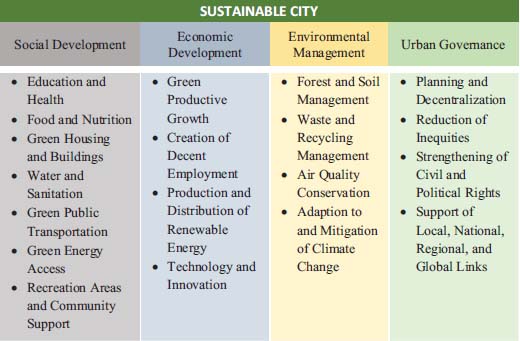
Figure 1.1. The four dimensions of a sustainable city
(source: adapted from UN (2013)7). For a color version of this figure, see www.iste.co.uk/karam/general.zip
Other academics (De Jong et al. 2015; Ahvenniemi et al. 2017) have recently recognized that understanding the rapports between people, their activities and the environment is key to sustainability. In this context, Bibri and Krogstie (2017) affirm that a sustainable city aims to achieve a dynamic balance between economic, environmental and socio-cultural development objectives (Figure 1.1) that are outlined by a local governance system that is characterized by increased citizen contribution.
This holistic vision of a sustainable city involves an efficient, local and balanced process that expands into all areas of local decision-making and aims to continually improve various urban systems, both design- and function-wise. The governance dimension is therefore essential as cooperative efforts from various stakeholders are needed to take an all-encompassing approach to solving the complex challenges of cities.
This rationale is hypothesized using the quadruple-helix model (Figure 1.2), in which universities, governmental authorities and the private sector join forces with the people, in order to find solutions to shared problems (Arnkil et al. 2010). Certainly, this archetype of collaborative urban governance – which is increasingly supported by ICT (Termeer and Bruinsma 2016) – has the potential to cut across outdated prerogatives and practices (Lubell 2015) and is seen as fundamental for the creation of a sustainable city (Kordas et al. 2015).

Figure 1.2. The quadruple-helix model
(source: adapted from SIP-SSC (2015)8)
1.1.3. The start of smart
While the sustainable city model was traditionally seen as the best option, it has nevertheless been superseded in recent years by the smart city model (De Jong et al. 2015). In fact, modern understanding of a smart city is integral to the advent and growth of ICT and computing (Harrison and Donnelly 2011; Kitchin 2014). In advanced economies, strong infrastructures, cutting-edge technologies and investment in energy efficiency are all quoted as the main ICT-driven benefits conferred to cities (Bibri and Krogstie 2017).
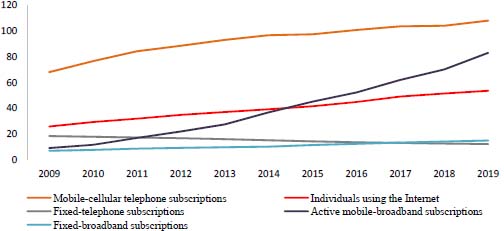
Figure 1.3. Global ICT developments, Y2009-19
(source: adapted from ITU (2019)9). For a color version of this figure, see www.iste.co.uk/karam/general.zip
Nowadays, although the fallout of the wide-scale deployment of ICT is still not fully understood – and an affordable and reliable Internet connection is still out of reach for the majority of people in the world – the network, both in terms of infrastructure and content, has grown rapidly since its inception and is stimulating vast innovation and improved user engagement (Figure 1.3). According to Turok (2014), increased deployment of ICT in the cities of emerging countries has been cited as a driver of efficacy in urban infrastructures, reducing the cost of city operations while supporting innovation and the eradication of poverty. In some instances, such as in Hong Kong and Singapore, urban economies tend to circumvent the need to retrofit existing infrastructure by incorporating ICT into new ones during their initial construction stages.
From our point of view, the burden is currently also put on the shoulders of governments; they are constantly seeking to gather and monitor data in connection with governance, infrastructure, the economy and the environment (UN-Habitat 2016). Kitchin (2014) affirms that the use of data allows cities to assess their performance in various aspects (from crime prevention to energy efficiency and investment) and thus improve the quality of their public offerings. Indeed, today, performance measurement has become a key element in the eyes of both officials and planners. This is the case because the use of data enables cities to not only measure their own performance and make evidence-based decisions, but also to compare and benchmark themselves against other cities, nationally and internationally. At this point, connectivity has reached a tipping point and the IoT is gradually being replaced by the Internet of Everything – cleverly dubbed as everyware – a network of networks where billions of connections could create unparalleled opportunities in making cities manageable in new, comprehensive and dynamic ways (Greenfield 2006).
Within this context, however, Silk and Appleby (2010) have indicated that the efficient exchange of information requires data accessibility, which is only possible via the publication and standardization of basic datasets: Open Data. Specifically, Open Data aims to strengthen the average citizen’s contribution to urban governance and is – to some extent – a commitment to transparency and accountability.
Before we conclude this present section, we wish to reiterate that the smart city concept is comparatively new and is still a contested topic and, out of interest, we proceed by asking: where did the idea of smart city technology come from? (Surprisingly, former USA president Bill Clinton takes all the credit for this one!) Back in 2005, through his charitable organization – The Clinton Foundation – he challenged network equipment provider Cisco to use its technical know-how to render cities more sustainable. As a result, Cisco devoted USD 25 million over a five-year period to research the topic, which led to the Connected Urban Development (CUD) program. The latter involved working with the cities of San Francisco (USA), Amsterdam (The Netherlands) and Seoul (South Korea) on a number of pilot projects to verify the technology’s potential.
In 2010, the year Cisco’s pledge expired, it launched its Smart and Connected Communities Division in order to commercialize the products and/or services that had been developed over the course of the program. Not long after, IBM had a similar vision to use IT (Information Technology) to make cities, say, smarter. At the time, both corporations were entirely focused on smart cities; however, their respective approaches to building those cities diverged significantly:
- – IBM’s strategy – on the one hand – was underpinned by its recent focus on information management and analytics. Through acquisition and internal R&D (Research and Development), the company succeeded in arming itself with analytical procedures and data processing technologies that are indispensable in understanding massive amounts of sensor data.
- – Cisco’s projects – on the other hand – ranged from modified or upgraded projects, such as their partnership with the Metropolitan Transit Authority in New York to improve rail and station monitoring, to completely new ones such as Songdo – a sustainable city to be built on reclaimed marshland in South Korea.
In conclusion, we wonder: did Cisco win the bet? Yes, in fact, it did because the investment made came first in the smart city make-a-thon. This instigated a global market whose current value measures up to billions of dollars, with hopeful prospects (Bloomberg’s!) to grow further in the future to reach USD 253 billion by 202510.
1.2. Definitions, features and models
A review of academic literature reveals that the use of the term smart city has increased exponentially – as of early 2009 – to the extent that it became the most prevalent classification for sustainable urban development (De Jong et al. 2015). It was the buzzword, drawing increased attention among research agencies, universities, governments, officials and specialized companies. All over the world, there has been hasty proliferation and promotion of smart city programs and the market potential for smart city solutions is set to be substantial (Etezadzadeh 2016). China, for instance, is urbanizing quickly and the Chinese government is currently pushing for renovation throughout its cities, with over 100 initiatives in the pipeline: eco-cities, low-carbon cities, as well as smart cities (SIP-SSC 2015). Similarly, a few years ago, India announced plans to develop smart cities in response to the country’s growing population and pressure on existing urban infrastructure (Smart Cities India 2015).
Today, although the concept of the smart city is still viewed favorably, implementing initiatives in countries with vastly different needs makes it difficult to establish shared definitions and common trends at the global level. That is, there is no clear-cut definition of the term smart city, or any general agreement on what its inherent features are (Caragliu et al. 2011; Dameri 2013; Kitchin 2014; Neirotti et al. 2014; Albino et al. 2015). In Latin America, for example, smart city projects tend to be weighted towards the improvement of security, local government management and mobility, whereas in Asia, the emphasis is instead on the improvement of infrastructure and mobility; there again, in Europe the aim is to boost efficiency in terms of the public offering, establishing a socially inclusive culture and enhancing citizen well-being (Neirotti et al. 2014).
According to SIP-SSC (2015), a smart city uses ICT to enhance livability, workability and sustainability. Similarly, the USA Office of Scientific and Technical Information11 affirmed that a city is qualified as smart if it integrates and monitors its critical infrastructure – including roads, bridges, tunnels, railways, seaports, water, power and major buildings – in order to optimize resources, formulate a preventive maintenance plan and monitor security while maximizing services to its citizens. Another astute smart city definition is that of Guerrero-Perez et al. (2013) who suggest that a smart city could be seen as a defined geographical area capable of efficiently managing resources, as well as the waste generated by those within it. From their perspective, Georg et al. (2012) suggest a reasonable macro-definition by describing smart city projects as: “[...] nothing but the sum of several interconnected, smart micro-projects (e.g. infrastructure, telecom and ICT, as well as smart buildings and districts)”. Thus, “a smart city project is an aggregation of a number of varied-sized and -shaped smart projects” they added.
Refer to Table 1.3 for an extensive – though not exhaustive – list of definitions for smart cities, from earliest to most recent.
Given the scope of this book and the objectives assigned to it, we devised our own definition of a smart city, which is as follows: “A smart city – we believe – is a city that is conceived, developed and run by the government and the people, both being smart, for the sake of promoting citizens’ well-being and ensuring a better quality of life for all”.
The term smart city first emerged out of the increased use of ICT, big data, the IoT and ubiquitous computing in cities. According to Caragliu et al. (2011), the smart city concept was described as a strategic tool to encompass modern urban production factors in a common framework and, in particular, to highlight the importance of ICT for enhancing the competitive profile of a city. So, to recap, a smart city is one that uses ICT strategically in its administration to provide efficient services to citizens, monitor policy outcomes, manage and optimize existing infrastructure, and employ cross-sector collaboration and enable new business models.
Table 1.3. Defining smart cities
(source: compiled from various sources)
| Definition | Author/s, Year |
| A smart city is one that monitors and integrates the conditions of all of its critical infrastructures to better optimize its resources, plan its preventative maintenance activities, and monitor security aspects while maximizing services to its citizens. | Hall (2000) |
| A smart city performs in a forward-looking way in terms of its economy, people, governance, mobility, environment and living, and is built on a combination of endowments and the activities of self-decisive, independent, and aware citizens. | Giffinger et al. (2007) |
| A smart city connects its physical infrastructure, ICT infrastructure, social infrastructure and business infrastructure to leverage the collective intelligence of the city. | Harrison et al. (2010) |
| Smart cities use smart computing technologies to make the critical infrastructure components and services of a city – which include city administration, education, healthcare, public safety, real estate, transportation and utilities – more intelligent, interconnected and efficient. | Washburn et al. (2010) |
| A city is smart when investments, in human and social capital and traditional and modern communication infrastructure, fuel sustainable economic growth and a high quality of life, with a wise management of natural resources, through participatory governance. | Caragliu et al. (2011) |
| A smart city infuses information into its physical infrastructure to improve convenience, facilitate mobility, add efficiency, conserve energy, improve the quality of air and water, identify problems and fix them quickly, recover rapidly from disasters, collect data to make better decisions, deploy resources effectively and share data to enable collaboration across entities and domains. | Nam & Pardo (2011) |
| Smart cities should embody two main ideas: 1) Smart cities are all about networks of sensors, smart devices, real-time data and ICT integration in every aspect of human life; and 2) Smart cities should do everything related to governance and economy using new thinking paradigms. | Cretu (2012) |
| A smart city is a high-tech intensive and advanced city that connects people, information and city elements using new technologies in order to create a sustainable, greener city, competitive and innovative commerce and increased quality of life. | Bakici et al. (2012) |
| A smart city is a well-defined geographical area, in which advanced technologies cooperate to create benefits for citizens in terms of well-being, inclusion and participation, environmental quality, intelligent development; it is governed by a well-defined pool of subjects, able to state the rules and policies for the city government and steer development. | Dameri (2013) |
| Smart cities use data, information and IT to provide more efficient services to citizens, to monitor and optimize existing infrastructure, to increase collaboration among different economic actors, and to encourage innovative business models in both the private and public sectors. | Marsal-Llacuna et al. (2015) |
| The smart-city concept is a tool for the creation of sustainable communities. It incorporates a mixture of transparent and collaborative governance schemes where citizen participation is key. | Simard (2015) |
Schaffers et al. (2011) similarly identify three key areas for potential smart city applications: the innovation economy, city infrastructure and utilities and city governance. They argue that in order to become smart, a city needs to (1) create a rich environment of broadband networks that support digital applications; and (2) initiate large-scale participatory innovation processes for the creation of applications.
The smartness of a city is thus determined by a set of physical and legislative infrastructures (Eremia et al. 2017) that support economic development, ensure social inclusion and enable environmental protection (Figure 1.4). Table 1.4 highlights the direction of developments in a city and provides examples of various applications through which the main objectives of a smart city could be achieved.
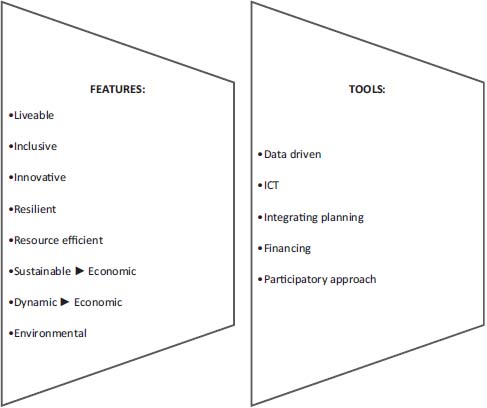
Figure 1.4. Smart cities’ features and tools
(source: adapted from Eremia et al. (2017))
We now progress by revealing the main smart city models, explicitly those of Giffinger et al. (2007), Cohen (2012) and Tobergate and Curtis (2014). The holistic models of Giffinger et al. (2007) and Cohen (2012) are largely seen to be the most illustrative in their capacity to demonstrate and exhibit the strategic components of a smart city by grouping them into six different areas (Figure 1.5).
Table 1.4. Direction of developments in smart cities
(source: adapted from Meijer et al. (2016))
| Area of application | Description | Examples |
| Smart Buildings | Incorporating the advantages of communication and control systems. | Optimizing the heating systems, ventilation and air conditioning. |
| Education, Health | Apps that improve the activity in these domains and ensure all citizens have access to high-quality services. | Monitoring systems of the elderly, monitoring by telemedicine. |
| Smart Energy | Smart electrical energy system that interconnects all utilities and end-users via smart infrastructures. | Smart Grid apps, optimization of network operation, complying with environmental standards, smart lighting. |
| Smart Grid | Real-time consumption metering of energy, water and natural gas. | Online information about consumption, wireless smart meters. |
| Smart Utilities | Intelligent management of the water distribution system and wastewater. | Smart wastewater systems, real-time solid waste monitoring. |
| Smart Parking | Managing parking places using sensors and CCTV. | Monitoring systems of the vehicles. |
| Integrated Supply Systems | Synchronizing supply and demand; measurement, monitoring and organization of the transportation around the supply chains of the cities. | n/a |
| Smart, Integrated Transport | Traffic monitoring and real-time optimization using all transportation means. | CCTV for traffic, smart parking networks, minimizing the impact on the environment. |
According to Giffinger et al. (2007), smart cities should be established on the basis of a smart combination of funding and activities, exactly as suggested by connected, self-governing intelligent citizens. Table 1.5 offers in-depth insights into the main components of a smart city.
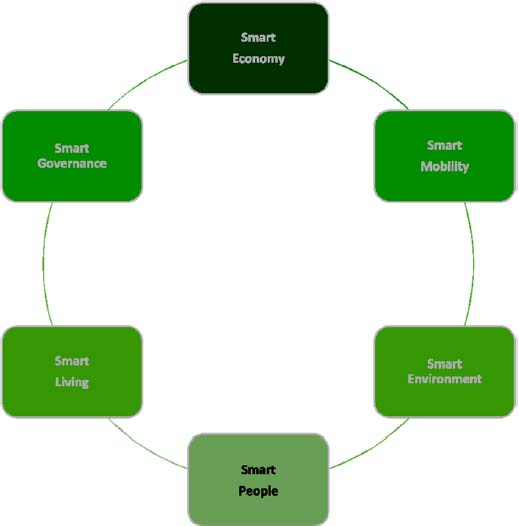
Figure 1.5. The main components of smart cities
(source: adapted from Giffinger et al. (2007))
These components were established in 2007 – as part of the European Smart Cities initiative – and therefore numerous authors (Batty et al. 2012; Lazaroiu and Roscia 2012) have referred back to them year after year to develop more elaborate frameworks and strategies. Boyd Cohen’s (2012) Smart City Wheel is one example (see Figure 1.6).
Table 1.5. A deep dive into the main components of smart cities
(source: adapted from Giffinger et al. (2007))
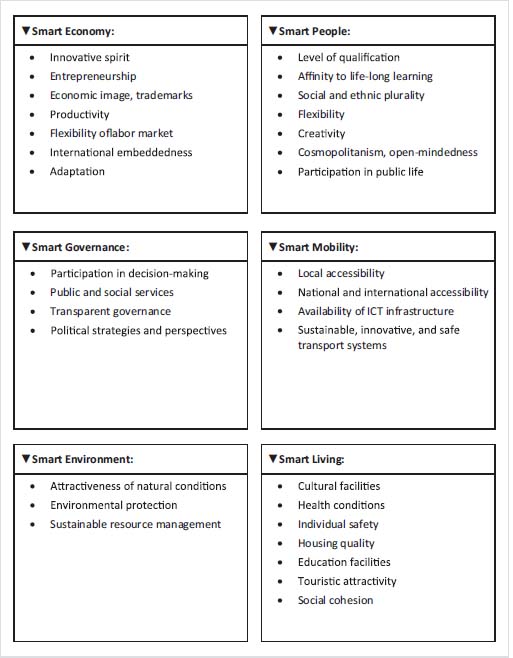
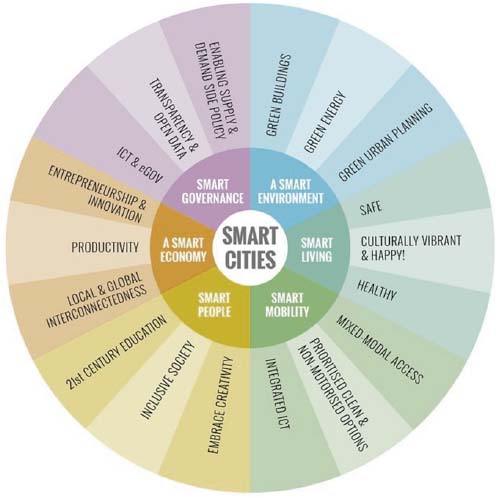
Figure 1.6. Smart City Wheel
(source: Cohen (2012)). For a color version of this figure, see www.iste.co.uk/karam/general.zip
A synthesis of the works of Giffinger et al. (2007) and Cohen (2012) by Simard (2015) allows for a better understanding of the relevance of smart city components vis-à-vis teething problems encountered by urban settlements today. According to Simard, it is crucial to have the support of governing bodies (as a first step) ex ante the start of any project process. Further, she states that, within the realm of smart cities, citizens must necessarily take part in this process by becoming active stakeholders and thus contributing to its success. To build on the work of Simard (2015), we chose to classify smart city components as primary or secondary. In our view, once the primary components have been securely rooted and established, the other (secondary) ones – four in total, all of equal importance – should follow (Figure 1.7). Indeed, no matter how well-governed a city is or how many smart people are part of it, we maintain that it cannot be qualified as smart unless it can demonstrate that all six primary and secondary components are in place.
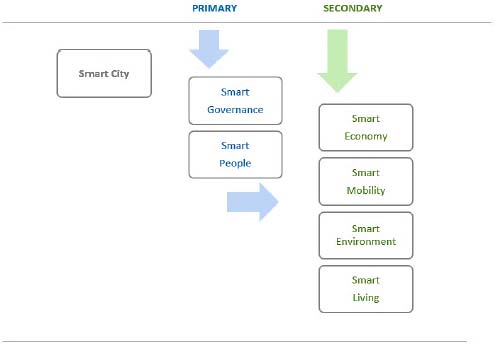
Figure 1.7. Giffinger et al.’s (2007) work revisited
(source: created by the author – inspired by Simard (2015)). For a color version of this figure, see www.iste.co.uk/karam/general.zip
Tobergate and Curtis (2014) have also made great use of existing work on smart cities by proposing a coherent illustration of the different aspects of a smart city. More precisely, they have added three factors (or rather, headings), under which all six smart city dimensions can sit.
Table 1.6. Core factors of smart cities
(source: adapted from Tobergate and Curtis (2014))
| Technology Factors | Human Factors | Institutional Factors |
|
• Physical infrastructure • Smart technologies • Mobile technologies • Virtual technologies • Digital networks |
• Human infrastructure • Social capital |
• Governance • Policy • Regulations and directives |

Figure 1.8. Smart city: factors versus components
(source: adapted from Tobergate and Curtis (2014)). For a color version of this figure, see www.iste.co.uk/karam/general.zip
As reported by Tobergate and Curtis, the factors (first layer) can be broken down to get to the components (second layer) (Figure 1.8); the factors, through their respective parts (see Table 1.6), would then act as a conductive thread for components (primary and secondary) that, combined, would ultimately fuel the development process of smart city strategies around the world. The next section features some real-life, global examples of smart cities and initiatives. Using easy-to-understand language, it briefly exposes international developments and improvements made in this field.
1.3. Examples of smart cities and initiatives
From smarter transit systems to greener buildings, smart cities are quickly transforming the way people think about urban living. To elucidate this global penchant for smarter urban living, five examples of smart projects and initiatives from around the world are given below. The proposed smart city tour begins in Europe (Spain) and ends in Asia (South Korea); the fifth edition of the IESE Cities in Motion Index (CIMI) inspired our choice of smart cities12.
As mentioned, the idea of smart cities is vague, with myriad associations (smart living, smart security, smart governance, smart people, smart anything and everything), and its connotations vary across continents, nations and cities (even within the same nation). We believe this reasoning helps us to substantiate the subjective nature of the term. Furthermore, though smart cities are relatively abundant today, history has shown that not all of them were destined to flourish (Remember? A top-down approach to building a smart city is likely to fail, particularly given that stakeholders often misinterpret the term smart city).
However, we must state here and now that not all smart cities are equally successful, genuine or human; thus, we raise the red flag on Songdo (South Korea) and Dubai (United Arab Emirates) for being mere technology demonstrators rather than habitable cities (Rochet 2014).
1.3.1. Barcelona, Spain
With 22 programs encompassing over 120 active projects that incorporate all areas of city management – from public space and mobility to open government – Barcelona was named European Capital of Innovation 201413. A year later, in 2015, it was labeled – along with New York, London, Nice and Singapore – one of the world’s smartest cities.
Since 2011, the city has worked hard and fast to turn the hypothetical smart city concept into a reality. Evidently, they have succeeded in doing so! Investment-wise, Cisco turned out to be one of the city’s key technology providers. It invested almost USD 30 million to build a new center focusing on the IoT for urban systems. Cellnex Telecom, a wireless telecoms company, then integrated existing city services into one system (the Urban Platform of Barcelona) and has been running the city-wide network ever since. Due to its extensive use of the IoT and the successful implementation of its strategies, Barcelona is now regarded as one of the global leaders in the smart city market. Actions implemented under the Barcelona Smart City strategy lie on three axes: international promotion, international collaboration and local projects. Among the various smart projects Barcelona has developed in recent years, we cite the following:
- – the Apps4 BCN portal, an application that provides a virtual meeting point portal for people to look for apps and improve their experience of the city;
- – smart transportation through which the city aims at showing its commitments in becoming the frontrunner in the utilization of renewable energy, particularly in the transit sector (e.g. the development of electric vehicles);
- – smart education, the so-called Smart City Campus, enabling supportive environments for businesses, research centers and universities to promote synergies and generate an urban laboratory;
- – smart governance via the establishment of an e-government program, the Open Data BCN, though which Barcelona intends to open up the city database to the public, in order to increase transparency and credibility; and also to provide and universalize open data access to reach all stakeholders. Beyond this, Barcelona has created a Smart City Personal Management Office with the purpose of coordinating and synchronizing all city projects and operations deemed smart.
1.3.2. Amsterdam, The Netherlands
Ordinarily, smart city projects should benefit the people who live, work and visit the city in which they are implemented14. In our view, these projects are a dynamic way of using technology to build a better working world. Amsterdam’s smart city initiative has now progressed from the early stages of experimentation, a trial-and-error phase which culminated in the city opening its data up to the public. Now in its second stage, the initiative is characterized by more solicitous and focused efforts that will ultimately enable the city to spur innovation and improve the quality of its offering. Table 1.7 below shows the main lessons that can be learned from Amsterdam’s experience in the area of smart city development.
Table 1.7. The five strengths of Amsterdam’s smart city
(source: Ernst and Young). For a color version of this table, see www.iste.co.uk/karam/general.zip
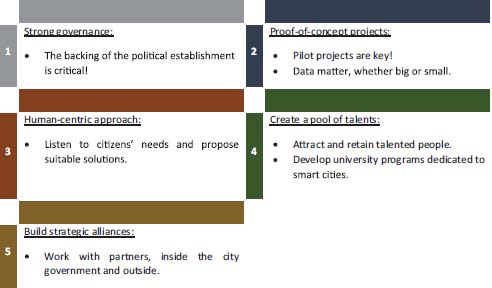
1.3.3. London, United Kingdom
London is a smart city global leader, known for developing innovative solutions and tackling urban challenges by making data accessible to all, at all levels15. Indeed, this was possible thanks to the London Datastore, a free and open data-sharing portal with over 700 datasets, launched back in 2010, and also to the recently implemented London Office of Data Analytics (LODA) program, which allows for increased data sharing and collaboration for the benefit of all Londoners. The Smarter London Together roadmap was first set in 2013 – and last updated in 2016, suggesting a new approach to building a smarter London based on collaborative activity between the city’s local authorities and public services. The city’s smart strategies incorporate plans to (among others): upgrade transit systems, improve the environment, shrink health inequalities, render housing affordable to all and stimulate economic development (Table 1.8).
Table 1.8. Towards a smarter London
(source: Greater London Authority, 2018: www.london.gov.uk/smart-london)
| Assignments | Strengths | Best practices |
• More user-designed services • Strike new deals for city data • World-class connectivity and smarter streets • Enhance digital leadership and skills • Improve city-wide collaboration | • City Data (London Datastore) • Data, tech and the environment (CleanTech, FlexLondon) • Data, tech and transport (Transport for London TfL)’s track record) • Data, tech and safety (Public Interactive Dashboards) • Data and test-beds (Queen Elizabeth Olympic Park) | • Put people first and respect diversity when designing digital services or adopting new technology • Lead in data innovation but build trust and transparency in how public data is used • Be better connected and open to new tech in the built environment • Strengthen digital leadership in public services and enhance the digital skills and understanding of citizens • Make city-wide collaboration and tech partnerships better to design and share what works for citizens across public and community services |
1.3.4. Copenhagen, Denmark
Copenhagen16, in contrast to other comparable cities around the world, is focusing its efforts on promoting the use of green technology and becoming carbon neutral by the end of 2025 (Figure 1.9). Today, the city is at the heart of clean technology innovation – it is Europe’s cleanest (and healthiest) capital – and is one of the greenest capitals in the world. Within this framework, the city has succeeded in reducing its carbon emissions by over 50% (between 1996 and 2025). Huge investments have been made in this respect, totaling USD 1 billion.
Bicycle lanes and super cycle highways were created, enabling half of the city’s residents to cycle (rather than drive) to work or school; Copenhagen’s vision is to become the world’s most bicycle-friendly city. Moreover, in order to alleviate congestion on the roads, the city installed a smart traffic management system to optimize traffic flow; it also encouraged citizens to adopt green modes of transport by setting a dynamic pricing model in motion that consists of adjusting toll and parking rates on demand. Aside from that, Copenhagen has gone further by installing cost-efficient waste collection and recycling systems, allowing the city to recycle half of its waste, most of which is used to fuel its district heating network (to which approximately 98% of households are connected). The city has also installed an energy-efficient district cooling system that relies on extracted cold seawater and leads to a substantiel reduction in energy consumption – nearly 70%, relative to a conventional air-conditioning system. (see Table 1.9 for a list of some of the elements of smart city projects and initiatives in Copenhagen).
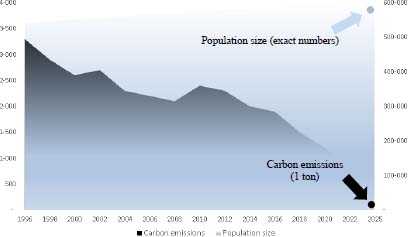
Figure 1.9. Copenhagen: carbon emission versus population size
(source: compiled from various sources). For a color version of this figure, see www.iste.co.uk/karam/general.zip
Table 1.9. Copenhagen: smart projects and initiatives
(source: compiled from various sources). For a color version of this table, see www.iste.co.uk/karam/general.zip
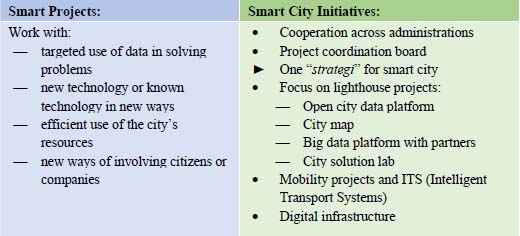
1.3.5. Seoul, South Korea
Songdo international city is part of the Incheon Free Economic Zone, along with Yeongjong and Cheongna. The function of each region is as follows (Sang Keon et al. 2016)17:
- – Songdo is in charge of international business relating to IT and BT (Business Technology), as well as R&D;
- – Yeongjong focuses on aviation logistics, tourism, and leisure; and
- – Cheongna concentrates on international finance, high-tech industry and distribution.
In terms of infrastructure, the area consists of the very famous Incheon International Airport18, which operates as the hub airport of northeast Asia. At present, Songdo is still under development, with plans to invest a few extra billions in it until 2022, to furnish the city and strengthen its infrastructure to accommodate additional residents in the future. Moreover, as part of the country’s project to build a cutting-edge green city, Songdo has been converted into a U-city (Ubiquitous-city) (see Table 1.10).
Table 1.10. Establishing Songdo city, targets and steps
(source: adapted from Sang Keon et al. (2016))

In general, the U-city in question is divided into public and private services (Figure 1.11). More precisely, public services are designed to provide around-the-clock services in various categories (traffic management and crime and disaster prevention)19, while private services are intended to provide facilities that will improve the quality of people’s day-to-day lives. As for eco-friendly services (U-bike, U-street, U-foreigner Support Mobile Service, etc.), they are offered as specialized services through the city’s U-IT platform.
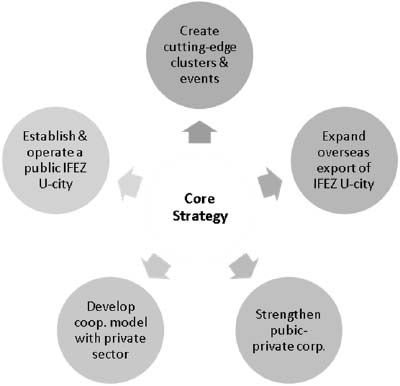
Figure 1.10. Songdo U-city’s core strategies
(source: adapted from Sang Keon et al. (2016))
Songdo U-city was based on a top-down managerial approach and executed using comprehensive plans and construction procedures. Tested in 2014, these procedures were used two years later, in 2016. However, the U-city looks like a front-line creation today; (sadly!) its present-day structure requires quite a few alterations ex ante the implementation of services. We believe that issues arose because of significant differences in what was requested and what was required at both the conception and construction stages of the project. In fact, technologies have been rapidly developed (in the past decade at least!) and citizens’ request levels (standards) have risen too. Therefore, aside from the high probability that the technology implemented will already be outdated upon project completion, the plans of related entities and on-site equipment need to be clearly defined as well, to avoid wasting the budget on duplicate systems, for example.

Figure 1.11. Songdo U-city integrated operations center
(source: adapted from Sang Keon et al. (2016))
Before moving on to the next section, in which an overview of the size and potential of the global smart city market is presented, we close this one by sketching a comparative table that summarizes the main components of 15 different smart cities.
Table 1.11 shows the various similarities and differences between international smart city models. If the data is interpreted column by column (i.e. read top to bottom), then the scores can be compared and the frontrunners invited up to the podium. However, if it is considered row by row (i.e. read left to right), the components could be ranked in order of importance20.
Table 1.11. Components of international smart city models: comparison
(source: created by the author)
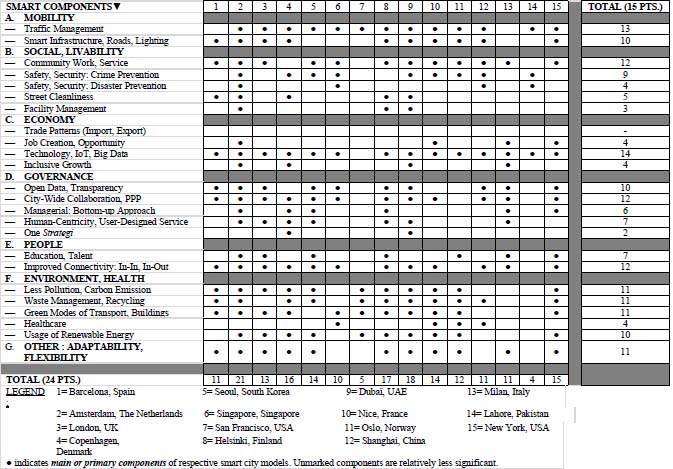
1.4. Smart city market outlook
Big cities now face growing pressure due to the snowball effect of urbanization. Therefore, the need for operative solutions for managing urban settlements and improving sustainability and livability has eventually led to the global surge in smart cities (Chui et al. 2018). Principally, smart cities denote the incorporation of ICT to boost the performance and quality of urban offerings in order to reduce resource consumption and costs21. Indeed, global ICT companies22 have been steadily pushing for the adoption of their technologies – a major catalyst in industry growth. Nonetheless, smart cities are developed and applied across a huge number of different domains and the smart city market, comprising of myriad sectors, is in no way exclusive to ICT. That is, all companies (regardless of the sectors they operate in) will eventually be forced to reconfigure their value chains and adapt their business models to up-and-coming market changes.
Driven by renewed interest from the industry, availability of technology and full participation of industry stakeholders, the global smart city market is expected to reach USD 2.3 trillion by 2023 and grow at a continuous CAGR (Compound Annual Growth Rate) of 29% thereafter23. Furthermore, estimates by Frost and Sullivan24 suggest that investments to be made in the smart city market, covering smart solutions that would lead to the adoption of a specific mix of smart parameters by cities, may possibly reach USD 1.6 trillion by 2020. Concisely, the global smart city market is segmented based either on location (Figure 1.12): North America, Europe, Asia-Pacific, Latin America and the Middle East and Africa; or on application (domain): building, healthcare, transportation, infrastructure, governance, security and energy (Figure 1.13).

Figure 1.12. Smart city market: growth rate by region, 2019-2024
(source: Mordor Intelligence25). For a color version of this figure, see www.iste.co.uk/karam/general.zip
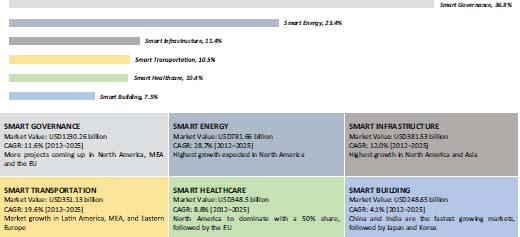
Figure 1.13. Global smart city market, by segments: 2016
(source: Frost and Sullivan Analysis26). For a color version of this figure, see www.iste.co.uk/karam/general.zip
Today, the smart city market stands to benefit from the initiative taken by governments, residents and businesses to implement projects and solve (pending) urban problems (Townsend 2013). The Smart Cities Council27 is a great example of a business-led initiative – the sector’s oldest and largest smart city network – that is sponsoring the interests of its members through advocacy and lobbying actions (SIP-SSC 2015). Certainly, for city officials, national governments and supranational states, smart city projects offer the enticing potential of creating more livable, secure, competitive and sustainable settlements – the reason why they are presently on the lookout for greater-than-before deregulation and privatization (Kitchin 2014). Within this context, we move on by asking: Are all cities destined to be smart?
1.5. Are all cities destined to be smart?
Through their studies of several European cities, Caragliu and Del Bo (2016) acknowledged that every city in the world has the potential to become smart. According to the authors, the smart city model is one of urban developments, a go-smart path along which cities could be spotted at various points. Chui et al. (2018), on another note, stated that smartness is an ongoing process and that lots of work is still to be achieved, even by the most advanced cities, to be able to cross the smart city make-a-thon finish line. “In fine, a smart city should be labeled by the objectives it intends to achieve rather than the countless solutions it has to offer – and so, a smart city is not a goal by itself, but a means to an end” they added.
By and large, smart cities cannot be reduced to the mechanical solutions that are implemented within them in order to rationalize operations. This is the case because this idea goes above and beyond to cover a series of factors and/or components that, if put together efficiently, could help cities make better decisions and boost their citizens’ quality of life (Rochet 2014; Etezadzadeh 2016). Literarily speaking, quality of life is a vague term with many dimensions – covering aspects from the quality of the air citizens breathe (environment, pollution), to how safe they feel walking the streets (safety, security), to how quickly then can travel between two points (transit, traffic), to how happy they feel in the neighborhoods they live in (sociability, livability), to a whole array of different things (Chui et al. 2018). This, to some extent, infers that smart city and quality of life are two inter-related notions, one leading to the other, both having the same resolves and goals.
Bettencourt et al. (2007) and Harrison and Donelly (2011) insist on the fact that it is better to regard a city as an adaptive complex system – a system of systems. Therefore, a given city – a complex living ecosystem of social interactions, that is – cannot be deemed smart unless the synergies and connections between its citizens are also considered to be smart. This idea was originally endorsed by Dedijer and Jequier (1987) and Cronin and Davenport (1991) who thought citizens to be at the heart of smart cities – not as mere receivers of information, but as producers too. At present, after years of trial-and-error, policy-makers around the world have finally realized that smart city projects start and end with people (Chui et al. 2018).
Furthermore, in order to circumvent dysfunctional urbanization (which was a popular sensation in the two past centuries!) – a smart city, in general, cannot be created if it is disconnected from its territorial history, culture, tradition and evolution (Etezadzadeh 2016). However, it should have its own modus operandi, and be conceived and built based on nation-specific forms. (Remember? There is no common model for smart city development – and a city cannot settle for copying good practices from other cities by importing and applying them ex nihilo.) Here and now, however, the smart city development phenomenon seems to have become viral, a global trend – its spread was (and it still is!) disproportionate – and here is why:
- – consortiums held to support the smart city market have only (at least so far) focused on specific regions and domains;
- – an absence of a systemic model that enables the global adoption of ICT as well as cohesive smart cities’ visions and strategies;
- – growing concerns with regards to data privacy and security;
- – a pronounced need among budget-conscious cities to verify ROI (Return on Investment) prior to a wider execution of smart plans;
- – lack of multi-stakeholder buy-in – and adequate financial models and resources that would support the development of smart city markets.
And so, we answer: by competently using their own resources and endowments, refining communication infrastructure and web-based services, allotting ample financial resources and adopting appropriate funding schemes and creating apposite value chains that ensure a fair interplay between stakeholders, all cities around the world could become smart, at different rates, each in its own form.
1.6. Conclusion
Up until now, we have shown that connectivity is key – and that functional geography has taken over. This new reality has reshaped and wired connections between countries; it has helped ease political tensions, mitigate environmental risks and uphold economic growth. Furthermore, we have indicated that people tend to migrate to big cities in search for more connectivity and opportunities. Urbanization has become a trend, transforming big cities into megacities, and megacities into smart cities. Long story short – smart cities are a combination of smart governments and smart citizens, and the government–citizen bond is lifted by the presence of smart technologies. Literally, big cities are being revamped to resemble smart villages, that is, to merge humans, nature and technology. For the construction of smart cities, we asserted that there would be a need for more adaptability and flexibility. Through the implementation of a new business model, a fair interplay among construction actors could be ensured. And this fair interplay is to be sustained – bringing Copenhagen’s case to mind – by a “ strategi”, an entity that could expertly orchestrate complex smart city projects: the general contractor.
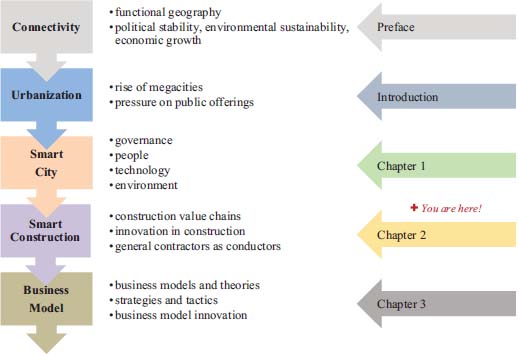
- 1 The Smart City in 2030. First Workshop on Network 2030, Otthein Herzog. New York City, October 2018. Available at: https://www.itu.int/en/ITU-T/Workshops-and-Seminars/201810/Documents/Ottein_Herzog_Presentation.pdf [Accessed April 7, 2021].
- 2 Xiong (2018). Cost-benefit analysis of smart cities technologies and applications. A thesis submitted to the Faculty of the University of Delaware. Available at: http://udspace.udel.edu/bitstream/handle/19716/23818/Xiong_udel_0060M_13359.pdf?sequence=1&isAllowed=y [Accessed April 7, 2021].
- 3 Our Common Future, that is, The Brundtland Report, was published in 1987. Targeting multilateralism and interdependence of nations in the search for a “sustainable development” path, it sought to recapture the spirit of the Stockholm Conference which had introduced environmental concerns to the formal political development sphere.
- 4 Sustainable Development. Available at: https://en.unesco.org/themes/education-sustainable-development/what-ís-esd/sd [Accessed April 10, 2021].
- 5 Also known as The Charter of European Sustainable Cities and Towns towards Sustainability. Available at: http://www.sustainablecities.eu/the-aalborg-charter/.
- 6 Melbourne Principles for Sustainable Cities. UNEP, Integrative Management, Series Number I, Division of Technology, Industry and Economics. Available at: https://archive.epa.gov/bns/web/pdf/melbourneprinciples.pdf [Accessed April 10, 2021].
- 7 United Nations (2013). World economic and social survey: Sustainable development challenges. Available at: https://www.un.org/en/development/desa/policy/wess/wess_current/wess2013/WESS2013.pdf [Accessed April 10, 2021].
- 8 SIP-SSC (2015). Strategic innovation agenda for smart sustainable cities. Available at: https://www.diva-portal.org/smash/get/diva2:812341/FULLTEXT01.pdf [Accessed April 12, 2021].
- 9 ICT Development Trends and Approaches for Digital Transformation. Available at: https://www.itu.int/en/ITU-D/RegionalPresence/AsiaPacific/SiteAssets/Pages/Events/2019/RRITP2019/ASP/ICT%20Development%20Trends%20and%20Digital%20Transformation%20ITU%20ITP%202019.pdf [Accessed April 12, 2021].
- 10 Bloomberg, Business. November 2019 Issue. See full report at: https://reports.valuates.com/sreport/QYRE-Othe-1K199 [Accessed March 30, 2021].
- 11 Found in Eremia et al. (2017).
- 12 IESE (2019). Cities in Motion Index 2019. Available at: https://blog.iese.edu/cities-challenges-and-management/2019/05/10/iese-cities-in-motion-index-2019/ [Accessed March 15, 2021].
- 13 Data in section 1.3.1 was taken from a consultancy report by Rahyaputra V., Khawarizmy N.M. and Saputri N.R., entitled “Barcelona’s smart city: The frontrunner in digital transformation”. Available at: http://cfds.fisipol.ugm.ac.id/uploads/files/posts/72/CFDS_CASESTUDIES_BARCELONA.pdf [Accessed December 27, 2019].
- 14 Inspired by a consultancy report by Frank Harmsen (E&Y Advisory) entitled “Amsterdam’s Intelligent Approach to the Smart City Initiative”. Available at: http://marketing.mitsmr.com/PDF/EY-SponsoredViewpoint-Amsterdam.pdf [Accessed March 15, 2021].
- 15 Section 1.3.3 summarizes the London Mayor’s roadmap to transform London into the smartest city in the world. The report is entitled “Smarter London Together”. Copies of the report are available at: www.london.gov.uk/smart-london [Accessed March 15, 2021].
- 16 Data taken from a presentation prepared by local authorities, entitled: “Copenhagen Smart City”. Available at: http://e97f7d10b0a403e208e5-9fbee7de8d51db511b5de86d75069107.r75.cf1.rackcdn.com/Copenhagen.pdf [Accessed December 27, 2019].
- 17 “International Case Studies of Smart Cities: Songdo, Republic of Korea”. Report published June 2016. Available at: https://publications.iadb.org/en/international-case-studies-smart-cities-songdo-republic-korea [Accessed March 15, 2021].
- 18 Ranked first for airport services (for 10 consecutive years), and second for international cargo transportation.
- 19 Songdo U-city collects 24-hour real-time data from on-site equipment such as CCTV, sensor devices and traffic detectors. Systems in Songdo are being built so that the data gathered could eventually be stored and analyzed in order to provide citizens, tourists and businesses with expedient public offerings.
- 20 The data shown in Table 1.11 is only indicative and must not, in any way, be seen as entirely representative. It was compiled for the purpose of this research project only and may include errors and/or inaccuracies.
- 21 The weakness of the current economic model lies in the fact that it is not sustainable, in the sense that it would reproduce the same negative externalities or dysfunctionalities encountered today (carbon emissions, waste production and urban nuisances).
- 22 ABB Limited, Accenture, Ericsson, Oracle Corporation, Hitachi, IBM, Schneider Electric, Cisco, Microsoft, Intel, Honeywell International, Huawei and Siemens (among others).
- 23 Transparency Market Research (2014). Rising trend of automation to drive global smart cities market growth. Available at: https://www.transparencymarketresearch.com/pressrelease/smart-cities-market.htm [Accessed April 19, 2021].
- 24 Smart Cities: Frost and Sullivan Value Proposition. Available at: https://ww2.frost.com/wp-content/uploads/2019/01/SmartCities.pdf [Accessed April 19, 2021].
- 25 Smart Cities Market – Growth, Trends and Forecast. Available at: https://www.mordorintelligence.com/industry-reports/smart-cities-market [Accessed April 19, 2021].
- 26 Smart Cities: Frost and Sullivan Value Proposition. Available at: https://ww2.frost.com/wp-content/uploads/2019/01/SmartCities.pdf [Accessed April 19, 2021].
- 27 For more information, please visit: https://smartcitiescouncil.com/.
